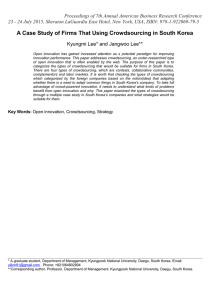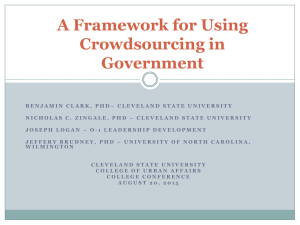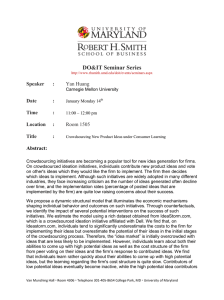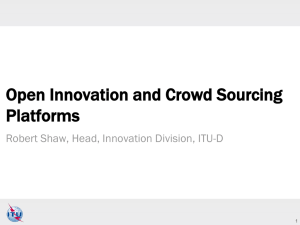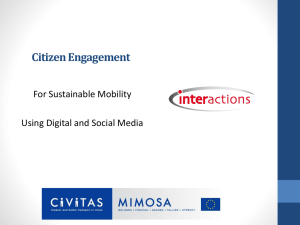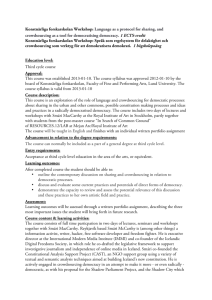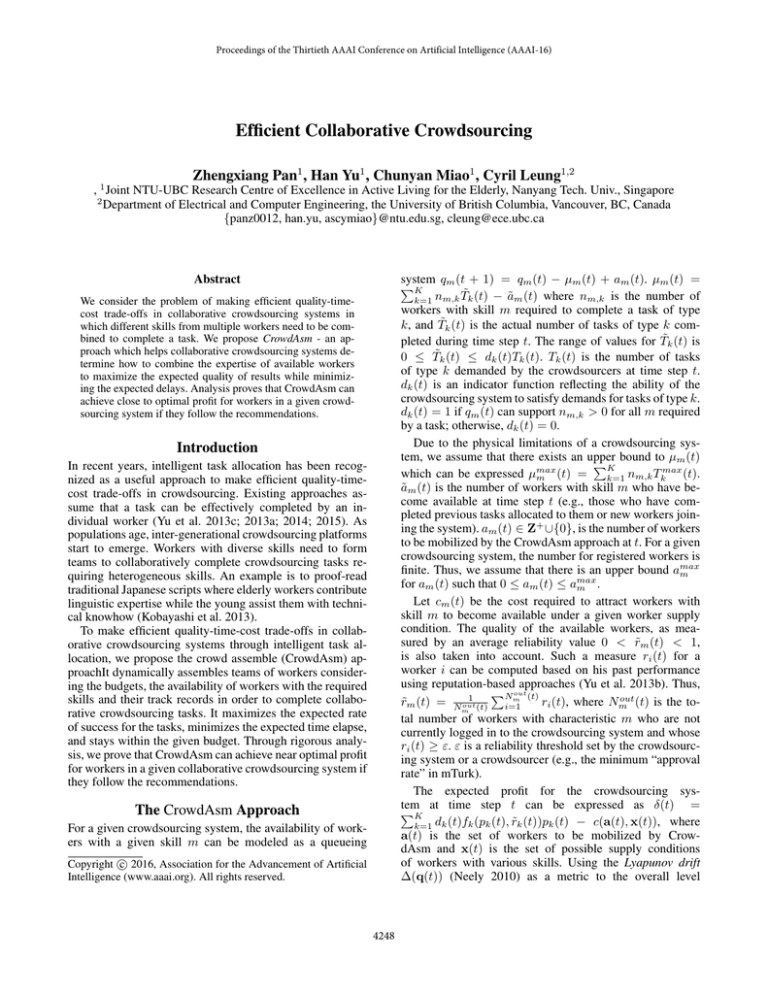
Proceedings of the Thirtieth AAAI Conference on Artificial Intelligence (AAAI-16)
Efficient Collaborative Crowdsourcing
1
Zhengxiang Pan1 , Han Yu1 , Chunyan Miao1 , Cyril Leung1,2
, Joint NTU-UBC Research Centre of Excellence in Active Living for the Elderly, Nanyang Tech. Univ., Singapore
2
Department of Electrical and Computer Engineering, the University of British Columbia, Vancouver, BC, Canada
{panz0012, han.yu, ascymiao}@ntu.edu.sg, cleung@ece.ubc.ca
system qm (t + 1) = qm (t) − μm (t) + am (t). μm (t) =
K
k=1 nm,k T̃k (t) − ãm (t) where nm,k is the number of
workers with skill m required to complete a task of type
k, and T̃k (t) is the actual number of tasks of type k completed during time step t. The range of values for T̃k (t) is
0 ≤ T̃k (t) ≤ dk (t)Tk (t). Tk (t) is the number of tasks
of type k demanded by the crowdsourcers at time step t.
dk (t) is an indicator function reflecting the ability of the
crowdsourcing system to satisfy demands for tasks of type k.
dk (t) = 1 if qm (t) can support nm,k > 0 for all m required
by a task; otherwise, dk (t) = 0.
Due to the physical limitations of a crowdsourcing system, we assume that there exists an upper bound to μm (t)
K
max
which can be expressed μmax
(t).
m (t) =
k=1 nm,k Tk
ãm (t) is the number of workers with skill m who have become available at time step t (e.g., those who have completed previous tasks allocated to them or new workers joining the system). am (t) ∈ Z+ ∪{0}, is the number of workers
to be mobilized by the CrowdAsm approach at t. For a given
crowdsourcing system, the number for registered workers is
finite. Thus, we assume that there is an upper bound amax
m
for am (t) such that 0 ≤ am (t) ≤ amax
m .
Let cm (t) be the cost required to attract workers with
skill m to become available under a given worker supply
condition. The quality of the available workers, as measured by an average reliability value 0 < r̃m (t) < 1,
is also taken into account. Such a measure ri (t) for a
worker i can be computed based on his past performance
using reputation-based approaches (Yu et al. 2013b). Thus,
out
N m
(t)
1
out
r̃m (t) = N out
ri (t), where Nm
(t) is the toi=1
(t)
m
tal number of workers with characteristic m who are not
currently logged in to the crowdsourcing system and whose
ri (t) ≥ ε. ε is a reliability threshold set by the crowdsourcing system or a crowdsourcer (e.g., the minimum “approval
rate” in mTurk).
The expected profit for the crowdsourcing system at time step t can be expressed as δ(t) =
K
k=1 dk (t)fk (pk (t), r̃k (t))pk (t) − c(a(t), x(t)), where
a(t) is the set of workers to be mobilized by CrowdAsm and x(t) is the set of possible supply conditions
of workers with various skills. Using the Lyapunov drift
Δ(q(t)) (Neely 2010) as a metric to the overall level
Abstract
We consider the problem of making efficient quality-timecost trade-offs in collaborative crowdsourcing systems in
which different skills from multiple workers need to be combined to complete a task. We propose CrowdAsm - an approach which helps collaborative crowdsourcing systems determine how to combine the expertise of available workers
to maximize the expected quality of results while minimizing the expected delays. Analysis proves that CrowdAsm can
achieve close to optimal profit for workers in a given crowdsourcing system if they follow the recommendations.
Introduction
In recent years, intelligent task allocation has been recognized as a useful approach to make efficient quality-timecost trade-offs in crowdsourcing. Existing approaches assume that a task can be effectively completed by an individual worker (Yu et al. 2013c; 2013a; 2014; 2015). As
populations age, inter-generational crowdsourcing platforms
start to emerge. Workers with diverse skills need to form
teams to collaboratively complete crowdsourcing tasks requiring heterogeneous skills. An example is to proof-read
traditional Japanese scripts where elderly workers contribute
linguistic expertise while the young assist them with technical knowhow (Kobayashi et al. 2013).
To make efficient quality-time-cost trade-offs in collaborative crowdsourcing systems through intelligent task allocation, we propose the crowd assemble (CrowdAsm) approachIt dynamically assembles teams of workers considering the budgets, the availability of workers with the required
skills and their track records in order to complete collaborative crowdsourcing tasks. It maximizes the expected rate
of success for the tasks, minimizes the expected time elapse,
and stays within the given budget. Through rigorous analysis, we prove that CrowdAsm can achieve near optimal profit
for workers in a given collaborative crowdsourcing system if
they follow the recommendations.
The CrowdAsm Approach
For a given crowdsourcing system, the availability of workers with a given skill m can be modeled as a queueing
c 2016, Association for the Advancement of Artificial
Copyright Intelligence (www.aaai.org). All rights reserved.
4248
all time steps t ∈ {0, 1, ..., τ − 1} yields:
of congestion of demand on workers with various skills
in the crowdsourcing system (i.e., expected delay), we
formulate the delay-minus-profit objective function as
Δ(q(t)) − ρE{δ(t)|q(t)} which is to be minimized. ρ > 0
is a control variable determining the relative importance
of delay and profit which can be set by a crowdsourcing
M
system. Δ(q(t)) ≤ ξ + m=1 qm (t)(am (t) − μm (t)),
M
2
max
2
where ξ = 12 m=1 [(amax
m (t)) + (μm (t)) ]. Thus, the
objective function can be re-expressed as:
Δ(q(t)) − ρE{δ(t)|q(t)} ≤ ξ +
M
τ
−1
t =0
−
qm (t)[E{(am (t)|q(t)}
nm,k E{βk r̃k (t)pk (t)|q(t)} + E{ãm (t)|q(t)}]
K
E{dk (t)[βk r̃k (t)pk (t)]pk (t)|q(t)}
M
m=1
E{
E{δ(t)} (2)
Conclusions
k=1
−ρ
t =0
Therefore, we have proven that the time averaged profit
achievable for a given crowdsourcing system following
CrowdAsm is within O( ρ1 ) of the optimal profit, subject to
the physical limitations of the crowdsourcing system.
k=1
+ρ
τ
−1
≤ τ ξ − τ ρδ opt .
As ρ > 0, dividing both sides of the above expression by τ ρ
τ −1
results in τ1 t=0 E{δ(t)} ≥ δ opt − ρξ + τ1 E{L(q(τ ))} −
1
τ E{L(q(0))}. Since L(q(t)) ≥ 0 and L(q(0)) = 0, we
have:
τ −1
1
ξ
(3)
E{δ(t)} ≥ δ opt − .
τ t=0
ρ
m=1
K
[E{L(q(t + 1))} − E{L(q(t))}] − ρ
In this paper, we proposed the CrowdAsm approach to dynamically assemble teams of workers considering the budgets, the availability of workers with the required skills and
their track records to complete crowdsourcing tasks requiring collaboration among workers with heterogeneous skills.
Theoretical analysis has shown that CrowdAsm can achieve
close to optimal profit for workers in a collaborative crowdsourcing system if they follow the recommendations.
cm (t)am (t)
|q(t)}
r̃m (t)
(1)
By choosing only terms containing am (t) from
Eq. (1), CrowdAsm needs to minimize the expression
M
cm (t)
m=1 am (t)[qm (t) − ρ r̃m (t) ], subject to the constraints:
max
1) a (t) ≤ am ; 2) ri (t) ≥ ε, ∀i ∈ am (t); and 3)
M m
m=1 cm (t)am (t) ≤ B(t), where B(t) is the budget
available for a given task.
To minimize Eq. (1), compute the values of the expression
(t)
] for all m. Sort all task requests in ascending
[qm (t)−ρ r̃cm
m (t)
Acknowledgements
This research is supported, in part, by the National Research
Foundation, Prime Minister’s Office, Singapore under its
IDM Futures Funding Initiative and administered by the Interactive and Digital Media Programme Office; and the Lee
Kuan Yew Post-Doctoral Fellowship Grant.
(t)
] values. For each group of
order of their [qm (t) − ρ r̃cm
m (t)
workers with skill m, send task requests to as many workers
am (t) as allowed by Constraints 1 to 3.
References
Kobayashi, M.; Ishihara, T.; Itoko, T.; Takagi, H.; and
Asakawa, C. 2013. Age-based task specialization for crowdsourced proofreading. In LNCS, volume 8010, 104–112.
Neely, M. J. 2010. Stochastic Network Optimization with Application to Communication and Queueing Systems. Morgan
and Claypool Publishers.
Yu, H.; Miao, C.; An, B.; Leung, C.; and Lesser, V. R. 2013a.
A reputation management model for resource constrained
trustee agents. In IJCAI’13, 418–424.
Yu, H.; Shen, Z.; Leung, C.; Miao, C.; and Lesser, V. R.
2013b. A survey of multi-agent trust management systems.
IEEE Access 1(1):35–50.
Yu, H.; Shen, Z.; Miao, C.; and An, B. 2013c. A reputationaware decision-making approach for improving the efficiency
of crowdsourcing systems. In AAMAS’13, 1315–1316.
Yu, H.; Miao, C.; An, B.; Shen, Z.; and Leung, C. 2014.
Reputation-aware task allocation for human trustees. In AAMAS’14, 357–364.
Yu, H.; Miao, C.; Shen, Z.; Leung, C.; Chen, Y.; and Yang,
Q. 2015. Efficient task sub-delegation for crowdsourcing. In
AAAI-15, 1305–1311.
Analysis
In this section, we analyze the performance of the CrowdAsm approach. Specifically, we are interested in the proximity of the time averaged profit for the crowdsourcing system to the optimal time averaged profit.
CrowdAsm observes the queues of available workers
with different skills q(t) at any time step t and helps
the crowdsourcing system determine the values of a(t)
to minimize Eq. (1). There exist at least a combination of a∗m (t) and μ∗m (t) values which satisfy all constraints and produce the optimal time averaged profit
E{δ ∗ (t)|q(t)} = δ opt for a given crowdsourcing system
such that Δ(q(t)) − ρE{δ(t)|q(t)} ≤ ξ − ρE{δ ∗ (t)|q(t)} +
M
∗
∗
m=1 qm (t)E{am (t) − μm (t)|q(t)}. As the optimal pol∗
icy results in E{am (t) − μ∗m (t)|q(t)} = 0 for all m, we
have Δ(q(t)) − ρE{δ(t)|q(t)} ≤ ξ − ρδ opt . Following the
definition of Δ(q(t)) and taking expectations on both sides
of the above expression, E{L(q(t + 1))} − E{L(q(t))} −
ρE{δ(t)} ≤ ξ − ρδ opt . Summing the above expression over
4249


